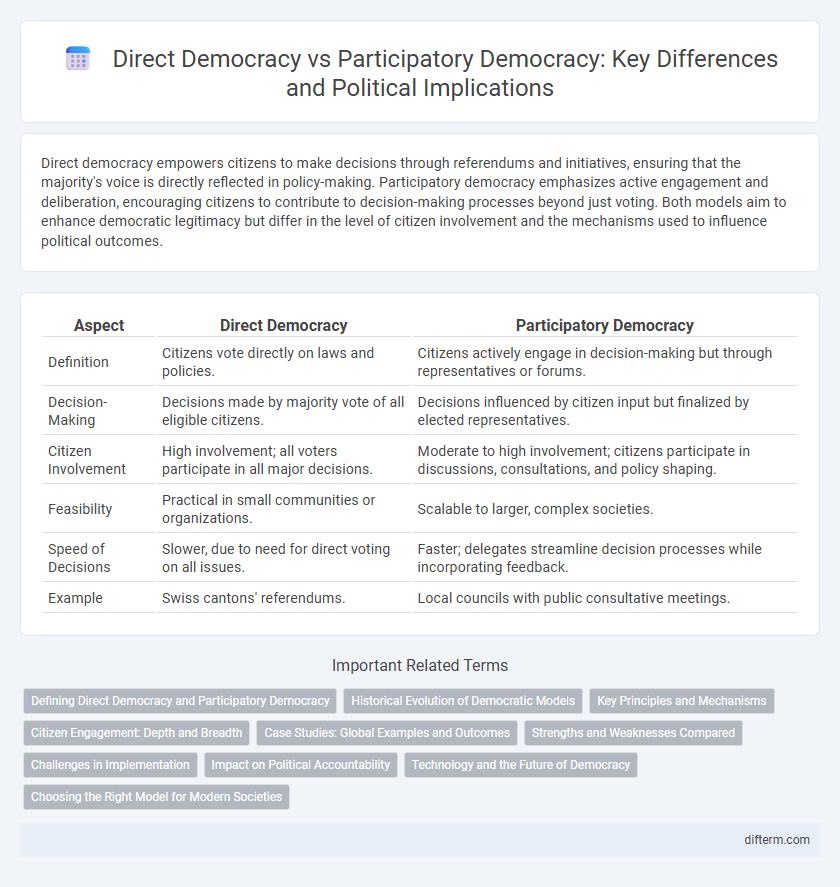Direct democracy empowers citizens to make decisions through referendums and initiatives, ensuring that the majority's voice is directly reflected in policy-making. Participatory democracy emphasizes active engagement and deliberation, encouraging citizens to contribute to decision-making processes beyond just voting. Both models aim to enhance democratic legitimacy but differ in the level of citizen involvement and the mechanisms used to influence political outcomes.
Table of Comparison
| Aspect | Direct Democracy | Participatory Democracy |
|---|---|---|
| Definition | Citizens vote directly on laws and policies. | Citizens actively engage in decision-making but through representatives or forums. |
| Decision-Making | Decisions made by majority vote of all eligible citizens. | Decisions influenced by citizen input but finalized by elected representatives. |
| Citizen Involvement | High involvement; all voters participate in all major decisions. | Moderate to high involvement; citizens participate in discussions, consultations, and policy shaping. |
| Feasibility | Practical in small communities or organizations. | Scalable to larger, complex societies. |
| Speed of Decisions | Slower, due to need for direct voting on all issues. | Faster; delegates streamline decision processes while incorporating feedback. |
| Example | Swiss cantons' referendums. | Local councils with public consultative meetings. |
Defining Direct Democracy and Participatory Democracy
Direct democracy empowers citizens to make decisions through referendums and initiatives, enabling immediate participation in governance without intermediaries. Participatory democracy encourages broader citizen involvement by integrating public dialogue and deliberation into policy-making processes, fostering collaboration between representatives and the electorate. Both models aim to enhance democratic engagement but differ in the mechanisms through which individuals influence political outcomes.
Historical Evolution of Democratic Models
The historical evolution of democratic models reveals that direct democracy, exemplified by ancient Athens, enabled citizens to vote on legislation personally, whereas participatory democracy emerged to expand citizen involvement beyond voting, emphasizing deliberation and community engagement. The transition reflects shifts in political theory from pure majority rule to inclusive governance mechanisms that address complex societal needs. Modern participatory democracy integrates digital platforms and local assemblies to enhance transparency and accountability, contrasting with the more limited scope of direct democracy in historical contexts.
Key Principles and Mechanisms
Direct democracy emphasizes citizens' direct involvement in decision-making through mechanisms such as referendums and initiatives, allowing individuals to vote on laws without intermediary representatives. Participatory democracy prioritizes broad citizen engagement in the political process via deliberative forums, citizen assemblies, and collaborative governance, fostering collective discussion and influence over policy development. Both models aim to enhance democratic legitimacy but differ in the degree of direct individual decision-making versus structured citizen participation.
Citizen Engagement: Depth and Breadth
Direct democracy enables citizens to engage directly in decision-making through referendums and initiatives, offering broad participation but often limited depth in understanding complex issues. Participatory democracy fosters deeper citizen engagement by involving individuals in deliberative processes, local assemblies, and policymaking discussions, enhancing the quality of involvement. Combining both models can optimize citizen engagement by balancing widespread involvement with meaningful, informed participation.
Case Studies: Global Examples and Outcomes
In Switzerland, direct democracy allows citizens to propose and vote on referenda, resulting in high public engagement and policies closely aligned with voter preferences. Brazil's participatory budgeting process in Porto Alegre exemplifies participatory democracy by involving citizens in municipal budget decisions, leading to improved public services and reduced inequality. Both models demonstrate that increased citizen involvement enhances government accountability, though the scalability and impact vary depending on institutional frameworks and political culture.
Strengths and Weaknesses Compared
Direct democracy empowers citizens to make decisions on legislation directly, enhancing political engagement and ensuring policies reflect majority preferences, but it may lead to majority tyranny and is often impractical in large, complex societies. Participatory democracy emphasizes continuous citizen involvement through deliberation and consultation, promoting inclusivity and diverse viewpoints, though it can suffer from slow decision-making processes and unequal participation due to resource disparities. Both systems prioritize citizen influence but balance trade-offs between efficiency, representation, and depth of involvement in governance.
Challenges in Implementation
Direct democracy faces challenges in implementation due to scalability issues and the risk of populism undermining informed decision-making. Participatory democracy struggles with ensuring broad citizen engagement and overcoming institutional inertia that limits meaningful influence on policy outcomes. Both models require robust digital platforms and civic education to enhance accessibility and sustained public participation.
Impact on Political Accountability
Direct democracy significantly enhances political accountability by enabling citizens to vote directly on laws and policies, reducing the gap between public will and governmental actions. Participatory democracy fosters accountability through sustained citizen engagement in decision-making processes, ensuring elected officials remain responsive to community needs. Both models strengthen political responsibility but differ in scale and frequency of citizen involvement in governance.
Technology and the Future of Democracy
Technology empowers direct democracy by enabling real-time voting through secure digital platforms, increasing citizen participation and transparency. Participatory democracy integrates technological tools to facilitate widespread deliberation and collaborative decision-making beyond just voting. Future democratic systems are likely to blend these approaches, leveraging AI and blockchain to enhance inclusivity, accountability, and efficiency in governance.
Choosing the Right Model for Modern Societies
Direct democracy enables citizens to vote on specific policies, ensuring immediate public involvement, while participatory democracy emphasizes ongoing engagement through deliberation and collaboration in decision-making processes. Modern societies face challenges like complex governance and diverse populations, making participatory democracy more adaptable by fostering sustained civic education and community empowerment. Selecting the right model requires balancing efficiency, inclusiveness, and the capacity to address contemporary social issues effectively.
direct democracy vs participatory democracy Infographic

 difterm.com
difterm.com